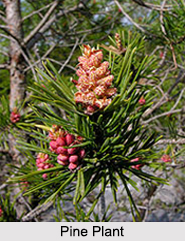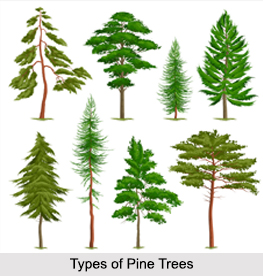 Pine oil is an essential oil obtained by the steam distillation of stumps, needles, twigs and cones from a variety of species of pine, particularly Pinus sylvestris. Essential oil of pine is used in paint thinners, paints, varnishes, etc. There are many types of pine tree. Pinus sylvestris, one of the varieties used to produce essential oil, grows widely throughout Europe and the USSR, the main distillation centers being in Austria and the USSR. The Pine oil acts as an expectorant, diaphoretic and antiseptic. It works on skin, blood, plasma and respiratory tissues. This oil can be mixed well with other oils like Birch, Eucalyptus, Myrtle, Sandalwood, Juniper, Citrus, Vetiver, Lavender, Cedarwood, Citronella and Rosewood.
Pine oil is an essential oil obtained by the steam distillation of stumps, needles, twigs and cones from a variety of species of pine, particularly Pinus sylvestris. Essential oil of pine is used in paint thinners, paints, varnishes, etc. There are many types of pine tree. Pinus sylvestris, one of the varieties used to produce essential oil, grows widely throughout Europe and the USSR, the main distillation centers being in Austria and the USSR. The Pine oil acts as an expectorant, diaphoretic and antiseptic. It works on skin, blood, plasma and respiratory tissues. This oil can be mixed well with other oils like Birch, Eucalyptus, Myrtle, Sandalwood, Juniper, Citrus, Vetiver, Lavender, Cedarwood, Citronella and Rosewood.
Pine Trees
A pine is any conifer in the genus Pinus of the family Pinaceae. Pinus is the sole genus in the subfamily Pinoideae. The Plant is compiled by the Royal Botanic Gardens, Kew and Missouri Botanical Garden accepts 126 species names of pines as present, together with 35 unresolved species and many more synonyms. Pine may also refer to the lumber derived from pine trees. Pine is one of the more extensively used woods as lumber. Pine trees are evergreen, coniferous resinous trees growing 3 to 80 meters (10 to 260 feet) tall, with the majority of species reaching 15 to 45 m (50 to 150 ft) in height. The smallest are Siberian dwarf pine and Potosi pinyon, and the tallest is an 81.79 m (268.35 feet) tall ponderosa pine located in southern Oregon`s Rogue River-Siskiyou National Forest.
The spiral growth of branches, needles, and cone scales may be arranged in Fibonacci number ratios. The new spring shoots are sometimes called "candles". They are covered in brown or whitish bud scales and point upward at first, then later turn green and spread outward. These "candles" offer foresters a means to evaluate fertility of the soil and vigour of the trees.
Pines grow well in acid soils, some also on calcareous soils and most require good soil drainage, preferring sandy soils, but a few (e.g. lodgepole pine) can tolerate poorly drained wet soils. A few are able to sprout after forest fires (e.g. Canary Island pine). Some species of pines (e.g. bishop pine) need fire to regenerate and their population slowly decline under fire suppression regimens.
Pine trees are beneficial to the environment. They can remove carbon dioxide from the atmosphere. Although several studies have indicated that after the establishment of pine plantations in grasslands, there is an alteration of carbon pools including a decrease of the soil organic carbon pool.
Uses of Pine Oil
In alternative medicine, Pine oil is said to be used in aromatherapy, as a scent in bath oils or more commonly as a cleaning product, and as a lubricant in small and expensive clockwork instruments. It may also be used varyingly as a disinfectant, sanitizer, microbicide (or microbistat), virucide or insecticide. It is also used as an effective herbicide where its action is to modify the waxy cuticle of plants, resulting in desiccation.
Pine oil is distinguished from other products of pine, such as turpentine, the low-boiling fraction from the distillation of pine sap, and rosin. The thick tar remaining after turpentine is distilled.
Chemically, pine oil consists mainly of a-terpineol and other cyclic terpene alcohols. It may also contain terpene hydrocarbons, ethers, and esters. The exact composition depends on various factors, such as the variety of pine from which it is produced and the parts of the tree used.
Pine oil is proven effective for the health problems stated below:
Thinking and memory. Early research suggests that taking vitamin C along with a specific product containing pine extract (Enzogenol) for 5 weeks improves thinking and memory in middle-aged and older men
Powerful antiseptic for the respiratory tract in cases of colds, influenza, pneumonia, asthma, sinusitis, bronchitis and laryngitis
Effective diuretic
 Good for cystitis
Good for cystitis
Good for gallbladder.
Helps prevent epidemics of influenza and other contagious diseases
Mild muscle pain
Nerve pain
Blood pressure problems
Common cold
Cough
Bronchitis
Fevers
Rheumatism
Wounds that are rebellious to healing
Also Pine oil is a disinfectant that is mildly antiseptic. It is effective against Brevibacterium ammoniagenes, the fungi Candida albicans, Enterobacter aerogenes, Escherichia coli, Gram-negative enteric bacteria, household germs, Gram-negative household germs such as those causing salmonellosis, herpes simplex types 1 and 2, influenza type A, influenza virus type A/Brazil, influenza virus type A2/Japan, intestinal bacteria, Klebsiella pneumoniae, odor-causing bacteria, mold, mildew, Pseudomonas aeruginosa, Salmonella choleraesuis, Salmonella typhi, Salmonella typhosa, Serratia marcescens, Shigella sonnei, Staphylococcus aureus, Streptococcus faecalis, Streptococcus pyogenes, and Trichophyton mentagrophytes.
Caution about Pine Oil
Pine is possibly safe when used appropriately by mouth for short periods of time. But sometimes pine pollen can cause an increase in allergic symptoms, even in people who test negatively to pine skin tests. Pine oil has a relatively low human toxicity level, a low corrosion level and limited persistence. However, it irritates the skin and mucous membranes and has been known to cause breathing problems. Large doses may cause central nervous system depression. The appropriate dose of pine depends on several factors such as the user`s age, health, and several other conditions. At this time there is not enough scientific information to determine an appropriate range of doses for pine.




